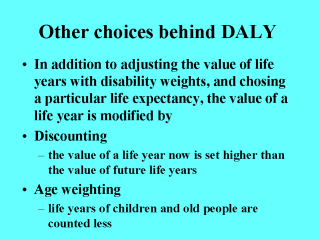 |
In the Global
Burden of Disease approach, future burdens are discounted at a rate of 3% per year, and
the value of the lifetime is weighted so that years of life in childhood and old age are
counted less. These choices are explained and discussed in (Murray, 1996). Discountingmeans
that future gains and losses are counted less than if they had occured today. This is
common practice when it comes to valuing material goods. For instance, a bank may require
500 dollars in 10 years time to compensate for a loan of 100 dollars today. However, it is
controversial whether if it is correct to apply discounting on human values. It has for
instance been asked why future generations should be counted as less valuable. |
